Talking SOP May 2013 [PDF, 735.49 Kb] - Tessenderlo Group
Talking SOP May 2013 [PDF, 735.49 Kb] - Tessenderlo Group
Talking SOP May 2013 [PDF, 735.49 Kb] - Tessenderlo Group
Create successful ePaper yourself
Turn your PDF publications into a flip-book with our unique Google optimized e-Paper software.
Sulphate of Potash news from <strong>Tessenderlo</strong> <strong>Group</strong> <strong>May</strong> <strong>2013</strong>SoluPotasse ® stays one step aheadof the competition<strong>Tessenderlo</strong> <strong>Group</strong> remains the world’s leading producer of water-soluble <strong>SOP</strong>,with innovative products such as SoluPotasse ® and K-Leaf. To stay one stepahead of the competition, it has developed a comprehensive database toquantitatively assess the benefits of water-soluble <strong>SOP</strong> products on the market.Nicolas White, Marketing Director Fertilizers, reveals the key aspects.What criteria do you use for assessing thequalities of a water-soluble <strong>SOP</strong>?We wanted to be sure that the parameters weuse are relevant to growers, so we set up severalworkshops with our distributors to identify thekey drivers from the growers’ perspective. Theyessentially fall into three categories: the product’schemical composition (K 2O, Cl content, etc.),physical characteristics (pH, dust, etc.) anddissolution properties (dissolution speed, totalsolubility and level of insolubles).Members of the R&D team analyse <strong>SOP</strong> samples.These parameters ensure that growers get thefull nutritional value they need for a particular cropand that the nutrients are readily taken up. Equallyimportant is that the user receives a product that iseasy to handle and dissolves quickly and completelyso there is no risk of clogging the irrigation system.We evaluated the relative importance customersattach to each parameter and from this derived thescoring system we use in our database.How does <strong>Tessenderlo</strong> <strong>Group</strong> measureproduct quality?For the production of SoluPotasse®, we regularlycheck 45 different chemical and physical propertiesto ensure a top quality product leaves the factory.And to benchmark our products, our dedicatedR&D experts also analyse samples of watersoluble<strong>SOP</strong> from our competitors. When ourISO 9001 accreditation for <strong>SOP</strong> productionat Ham was renewed earlier this month, theauditors congratulated us on our excellent qualitymanagement process and control system.What information is contained in thedatabase?Over the last five years we have analysed more than100 samples covering most of our competitors.The R&D team uses some 20 parameters deemedimportant by the market. Having identified the rangeof values for each and applied the parameter’simportance weighting, we can score productson a sliding scale. This creates a real “fingerprint”for each product and also gives us an accurate,transparent view of how SoluPotasse® performsin the market. In many cases, we can now identifythe producer of a particular water-soluble <strong>SOP</strong>based on the analysis results. We can also rapidlyreassure distributors and growers if quality-relatedissues arise.How does SoluPotasse ® rate against thecompetition?Some producers have recently made progress butresults confirm that it continues to lead the field. Thedatabase rates products on a scale of 0-200, withexcellent fertigation products such as SoluPotasse®scoring in the range of 140-160. Our innovativenew K-Leaf grade, specially developed for foliarapplication, scores around 180. No other producton the market today comes close to this.At the other end of the scale, any <strong>SOP</strong> productscoring below 80 can really be considered as astandard powder grade. Typically, these productsare non-acidic and have poor dissolution speedsand relatively high levels of insolubles. They canpose real problems for fertigation systems. Inbetween, there are a variety of products. <strong>SOP</strong>produced by the Mannheim process tends to scorewell because its acidic nature facilitates dissolution(cont. on page 4)In this issueSoybeans: a success story p2,3Supporting our customerswhen problems occur p4New SalesDirector for <strong>SOP</strong><strong>Tessenderlo</strong> <strong>Group</strong> announces theappointment of Mark Wilde, who joinsBusiness Unit Inorganics as SalesDirector Sulphates.In this position, Mark becomes responsiblefor the <strong>SOP</strong> sales team. He previously workedfor 12 years at Cytec, most recently as GlobalBusiness Director for the Specialty AdditivesDivision. Mark joined BU Inorganics on March 1 stand is based in Brussels.“This is a challenging and exciting period for<strong>Tessenderlo</strong> <strong>Group</strong>,” he says. “I am delighted tojoin the rapidly evolving <strong>SOP</strong> business and lookforward to working closely with our customersand the sales team to drive overall performanceimprovement.”Paolo Cerato will continue to lead the Aliphossales team in his revised role as Sales DirectorPhosphates. Mark’s appointment reflects thedesire of the Tessendelo <strong>Group</strong> to strengthenits <strong>SOP</strong> sales resources and to improve itscompetitiveness.K-Leaf TM SoluPotasse ® GranuPotasse ® Standard <strong>SOP</strong>
was brought to America by a sailor returning fromChina. Its main development in the USA startedafter the Second World War, and was followedby development in Argentina and Brazil from the1970’s onwards (Fig. 1).Soybeans:a success storyDevelopment of the soybean crop is unique in the world of agriculture. At the end ofthe 19 th century, cropping was primarily limited to Asia. However, a large expansionin production started in the 20th century after the Second World War, first in theUSA and in the 1970’s and 80’s in South America, mainly in Brazil and Argentina.Soybeans now cover the fourth largest acreage in the world after wheat, maize andrice, with 260 million tons produced on more than 103 million hectares.Main soybean production andcropping areasCountry Production Area(tons)(ha)USA 83,171,600 29,799,800Brazil 74,815,400 23,968,700Argentina 48,878,800 18,764,900India 14,485,105 9,950,000The soybean is a leguminous vegetable of thepea family. It is primarily grown for oil but also isa valuable source of protein and is widely usedin human and animal nutrition. The plant grows intropical, subtropical and temperate climates andwas first domesticated in the northeast of Chinamore than 2000 years ago.By the 15th and 16th centuries, the soybean hadbeen introduced into India and Japan as well asinto several countries in South East Asia. But itwas not until the end of the 19th century that itFor centuries in Asia, the soybean was usedmainly for preparing a large variety of fresh,fermented and dried foods. It was not used toany great extent for animal feed, contrary to inthe USA where its first use was for forage and, tosome extent, as green manure. As a legume, theplant also improves soil fertility by fixing nitrogenfrom the atmosphere.The soybean consists of 20% oil, more than 36%protein, 30% carbohydrate and good quantities offibre, vitamins and minerals. Today, the majorityof the crop is processed into oil and meal and itaccounts for around two thirds of the edible fatsand oils consumed in the USA.Soybean oil is also used by industry and, morerecently, as a biofuel product. The high proteincake resulting from oil extraction can be processedinto soybean flour for human consumption orincorporated into animal feeds to complementmaize and wheat grains.Soybean croppingSoybeans grow in a warm, moist climate, similarclimatic conditions as for maize. The minimumtemperature for effective plant growth is about10°C, as lower temperatures tend to delayflowering. Effective cultivation requires a welldrainedloamy soil with a pH from 6.0 to 7.5.Sodic and saline soils inhibit germination of theseeds and should be avoided.On soils prone to leaching, mineral fertilization canbe split into two or more applications and on lowfertility soils, it is often more efficient to apply thefertilizer in a band along the seedling row.China 12,282,000 7,650,057Paraguay 8,309,790 2,805,470Canada 4,246,300 1,542,400Fig. 1: Evolution of soybean global productionand cropping area 1961 - 2011Russia 2,299,860 1,187,400Ukraine 2,264,400 1,110,300Bolivia 1,756,010 1,023,960Uruguay 1,541,000 862,100Other 6,865,606 4,328,159Total 260,915,871 102,993,246Source: FAO <strong>2013</strong> (data from 2011)K-Leaf TM SoluPotasse ® GranuPotasse ® Standard <strong>SOP</strong>
Phosphorus and potassium requirements (IFA <strong>2013</strong>)Soil test levelRecommended fertilizer nutrients (kg/ha)*P 2O 5K 2OLow or normalclay contentHigh claycontentLow 40 - 60 100 - 150 120 - 180Medium 30 - 40 50 - 100 70 - 100Adequate 0 - 30 0 - 50 0 - 70High 0 0 0*For expected yields of 2,500 - 2,700 kg/ha; for each additional 1,000 kgadd an extra 10 - 15 kg P 2O 5/ha and 20 - 30 kg K 2O/ha.The soybean is able to fix adequate atmosphericnitrogen to produce yields of 3,000-4,000 kg/ha,if the nodules are well developed. Phosphorus istaken up throughout the growing season, withthe period of greatest demand starting just beforethe pods begin to form and continuing until about10 days before the seeds are fully developed.Potassium remains the most important mineralnutrient, particularly during rapid vegetativegrowth and seed formation. Any deficiencyshows up as chlorosis along the outside edges ofleaves, especially the older ones. Deficiencies ofmicronutrients are more common than with mostother field crops and shortages of Fe, Mn, Mo andZn can be observed in some cases.Potassium deficiency in soybean leafis illustrated in an experiment comparing the useof <strong>SOP</strong> and MOP in soil with an EC of 1.4 dS/m(Fig. 2).Kg/haFig. 2: Effect of potash form on soybean yieldin saline conditionsSource: SWRI, Iran 2003K-Leaf in soybean productionK-Leaf water-soluble <strong>SOP</strong> has been speciallydeveloped by <strong>Tessenderlo</strong> <strong>Group</strong> for foliarapplication and can be used to correct apotassium deficiency more quickly and efficientlythan soil application.Another interesting effect of its application isincreased root absorption of potassium. Thisis clearly illustrated in series of experimentsrecently carried out in Argentina on soils rich inavailable potassium. Results show an averageMt/haFig. 3: Effect of foliar application of K-Leafon soybean productionSource: INTA, Argentina 2011yield increase of 10 to 15% when 7.5 kg/ha ofK-Leaf is applied (Fig. 3). As potassium is nota limiting factor in these soils conditions, theadditional yield is due to its better assimilationthrough the roots stimulated by a better plantmetabolism.Today soybeans are considered a major source ofoil and proteins for human nutrition and livestockproduction. Potassium fertilization can help toincrease the yield and quality of the soybean cropthrough better mineral nutrition.Foliar application of water-soluble <strong>SOP</strong> suchas K-Leaf is a new concept in the fertilizationof broad acre crops that can enhance rootabsorption of nutrients to increase the efficiencyof soil-applied fertilizers or the natural fertility ofthe soil.Sulphur deficiency in soybean leaf<strong>SOP</strong>: beneficial for yieldOn soils that are low in organic matter and prone toleaching, potassium should preferably be appliedin the sulphate form. As the crop is sensitiveto sodicity and salinity, potassium sulphate isrecommended in these conditions. This sensitivityK-Leaf TM SoluPotasse ® GranuPotasse ® Standard <strong>SOP</strong>
SoluPotasse ® stays one step ahead (cont. from page 1)speed and minimizes insolubles. Soluble <strong>SOP</strong>derived from natural brines or mineral ores scorewell on chemical composition but dissolutionspeed and solubility are often disappointing.Why is this information important to growers?To make a purchase decision, growers need fulltransparency in the trade off between productquality and price. In extreme cases, where standard<strong>SOP</strong> has been sold as a water-soluble grade, theyhave often been severely disappointed with itsperformance and encountered serious problemswith their fertigation systems.Via our distributors, we hope we can educategrowers so that they can make more informeddecisions about the water-soluble products theybuy. While there will always be some whoseprincipal focus is price, they need to be aware thatthey are unlikely to get a high quality product.For a relatively modest premium, growers canbenefit from SoluPotasse®, a high quality productwhich dissolves quickly completely and delivers asuperior concentration of potash and sulphur totheir crops. It is encouraging that this fact does notgo unnoticed in many markets.We are are now using our database to ensure thatour products remain ahead of the competition.What guarantees does the group offer?Our factory goes to great lengths to ensure thatit consistently produces high quality <strong>SOP</strong> and theproduction is ISO9001 certified. We also aim toensure that this arrives at our customers in thesame condition, but we cannot plan for everyeventuality so there will be cases when mishapsarise.To help protect our customers against shipmentproblems, we can provide insurance cover on all oursales of <strong>SOP</strong>. Product delivered by truck, containeror ship is sold on a CIP (Carriage and insurancepaid to named destination) or CIF (Cost, insuranceand freight to named port) basis, an importantbenefit. However, customers need to ensure theyfully understand these Incoterms, particularly withrespect to the transfer of risk.For example, if a product is sold on a CFR (Costand freight to named port) basis, the risk andinsurance costs pass to the buyer of the productwhen the seller delivers it on board the ship, eventhough the seller pays the transportation coststo the destination port. This can sometimes beoverlooked with unpleasant consequences.How should customers react to a problem?Immediately a problem is identified, the customer’smost important action is to stop the dischargeoperation. Photographs should then be taken toillustrate the damage and he should immediatelycontact the insurance company. We provide aninsurance certificate with all our export shipments,which sets out the insurance conditions andprovides details of a local contact in case of aSupporting our customerswhen problems occurNo business is totally free of complaints and when issuesoccur <strong>Tessenderlo</strong> <strong>Group</strong> has a dedicated team to assist itscustomers so that problems can be resolved in a speedy andprofessional manner. David Vanderheyden, Claims &Complaints Manager, explains his team’s work and thesupport the group offers its <strong>SOP</strong> customers.claim. The customer may also decide to inform hiscommercial contact at <strong>Tessenderlo</strong> <strong>Group</strong>. In fact,for CIP shipments by truck, this should always bethe case as no insurance certificate is supplied.Fertilizer transport by container.If intervention by a local insurance agent is slow,we can intervene and will do everything possibleto speed up the process. As a legal formality,it is also important that the customer issues a‘letter of protest’ holding the carrier or transporterresponsible. A template for this can also be foundon our insurance certificate.In most cases, the insurance company is able toresolve claims efficiently without our intervention.However, if your claim appears not to be covered,we advise you to hand it over to us for furtherconsideration and action. We receive quarterlyfeedback from our insurance broker, so we canmonitor all the claims we receive.What are the most common errors to avoid?The most common reaction is to continuedischarging the product, even after the damagehas been noted. This potentially invalidates theinsurance. Another understandable reaction is tofail to alert the insurance company immediately, inorder not to interrupt the discharge operation. This,unfortunately, can also endanger the rights of theclaimant.As with all insurance policies, there are proceduresto follow and time limits to respect (3 days for seatransport and 7 days for other modes). Failing tocarry out the correct procedures risks invalidatingthe insurance cover. In case of doubt, pleasecontact the complaints department at <strong>Tessenderlo</strong>which will be happy to guide you.But, while we take great care to ensure our <strong>SOP</strong>products are delivered in good condition, wecannot be held responsible for damage occurringafter the point of delivery specified in the Incoterms.Once the transfer of ownership and risk takesplace, individual customers are responsible forensuring that any onward transport and handlingdoes not damage the product.How is the <strong>Tessenderlo</strong> <strong>Group</strong> <strong>SOP</strong> businessperforming at present?We have made excellent progress and over the pastcouple of years, complaints relating to deliveries of<strong>SOP</strong> have fallen by around 50%. The frequency ofcomplaints relating to SoluPotasse® has also fallensubstantially and is now less than 1%. This is aconsiderable achievement considering the fact thatwe annually ship over one hundred thousand tonsof this product, mostly in containers, to more than80 countries worldwide.We will maintain our efforts to minimize anyproblems so that our customers can continueto rely on <strong>Tessenderlo</strong> <strong>Group</strong> when quality reallycounts. To ensure that complaints are treated asrapidly as possible, customers should send themto our centralized mailbox:complaints@tessenderlo.com.More information on <strong>Tessenderlo</strong> <strong>Group</strong>’sactivities can be found at:www.tessenderlogroup.com<strong>Tessenderlo</strong> <strong>Group</strong> Fertilizersgiving nature a helping handwww.sopib.com<strong>Tessenderlo</strong> <strong>Group</strong>Troonstraat, Rue du Trône 130 B-1050 Brussels, BelgiumTel: + 32 2 639 1858 Fax: + 32 2 639 1713www.tessenderlogroup.comfertilizers@tessenderlo.comSoluPotasse ® and GranuPotasse® are registered trademarks of <strong>Tessenderlo</strong> Chemie NV/SA.K-Leaf TM is a trademark of <strong>Tessenderlo</strong> Chemie NV/SA.


![Talking SOP May 2013 [PDF, 735.49 Kb] - Tessenderlo Group](https://img.yumpu.com/41045284/1/500x640/talking-sop-may-2013-pdf-73549-kb-tessenderlo-group.jpg)
![Slides [PDF, 378.59 Kb] - Tessenderlo Group](https://img.yumpu.com/49205668/1/190x143/slides-pdf-37859-kb-tessenderlo-group.jpg?quality=85)
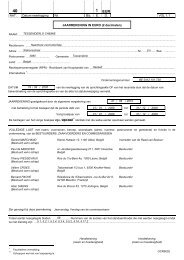
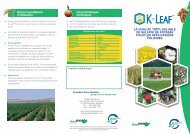
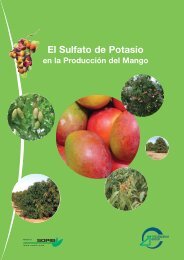
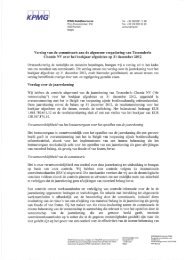

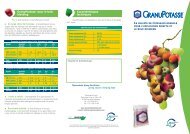
![Investor Seminar Presentation [PDF, 997.72 Kb] - Tessenderlo Group](https://img.yumpu.com/45992427/1/190x143/investor-seminar-presentation-pdf-99772-kb-tessenderlo-group.jpg?quality=85)
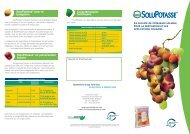
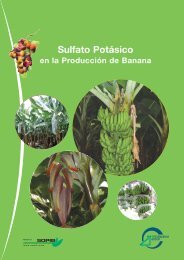
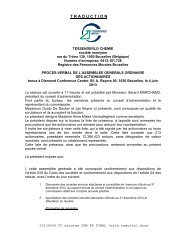
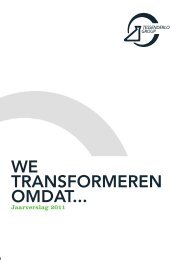
![Talking SOP September 2012 [PDF, 673.84 Kb] - Tessenderlo Group](https://img.yumpu.com/37691694/1/184x260/talking-sop-september-2012-pdf-67384-kb-tessenderlo-group.jpg?quality=85)
![Annual Report 2008 English [PDF, 2.69 MB] - Tessenderlo Group](https://img.yumpu.com/37691533/1/184x260/annual-report-2008-english-pdf-269-mb-tessenderlo-group.jpg?quality=85)